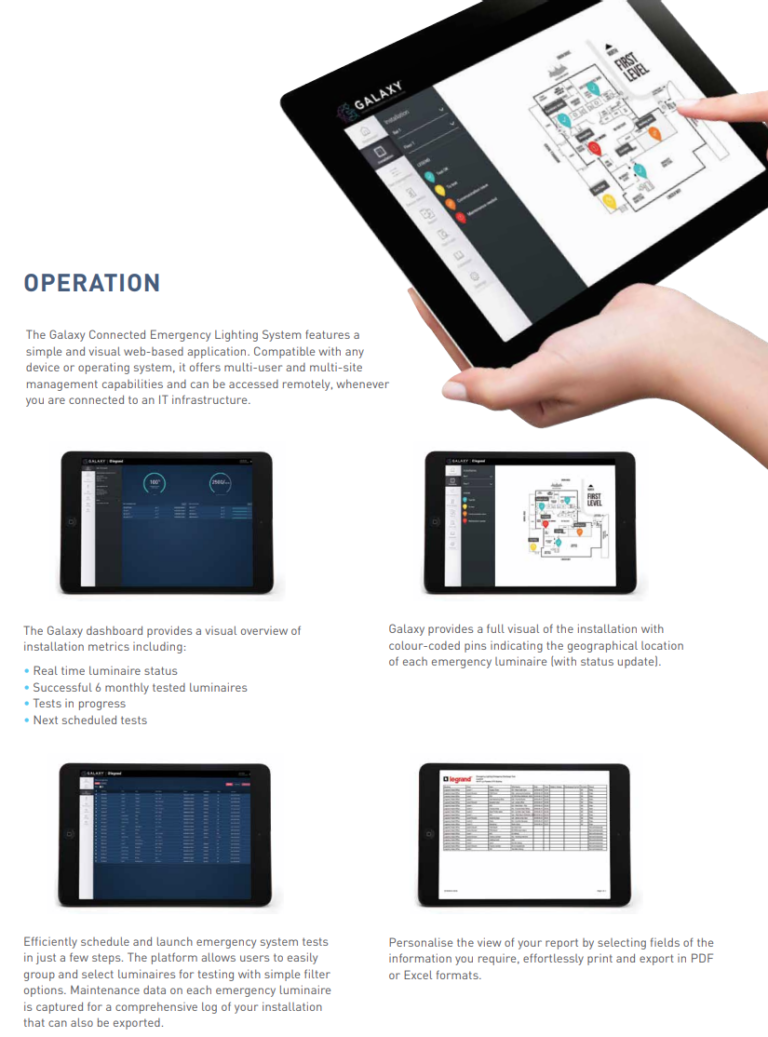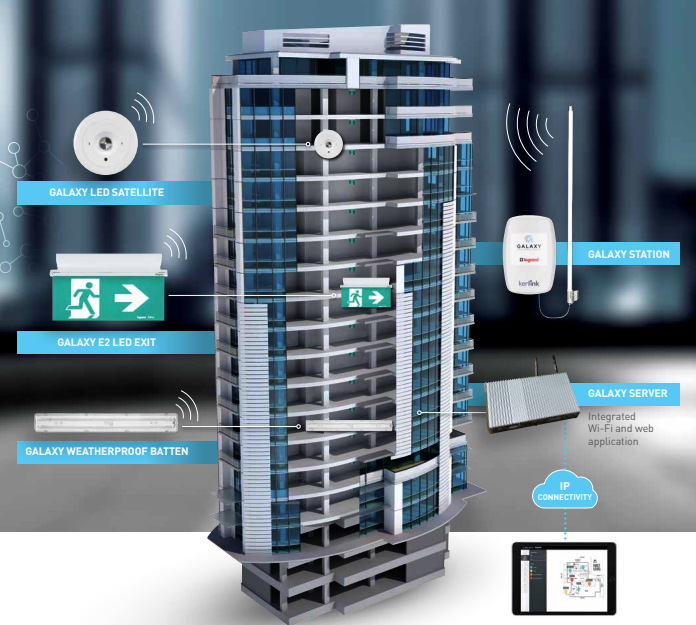As a leading provider of innovative emergency lighting solutions, we are proud to present our comprehensive guide to connected emergency lighting in smart buildings. This guide will help you understand the importance of advanced emergency lighting systems, their benefits, and how to implement them in your smart building project.
Introduction to Smart Buildings
Smart buildings are structures designed with integrated technology to optimize energy efficiency, comfort, and safety. They rely on advanced systems and automation to provide intelligent control over various aspects, such as lighting, HVAC, and safety.

The Role of Emergency Lighting in Smart Buildings
In smart buildings, emergency lighting plays a crucial role in ensuring the safety of occupants during power outages, fires, or other emergencies. These systems provide essential illumination for escape routes, exit signs, and fire safety equipment, enabling individuals to navigate their way to safety quickly and efficiently.

Key Features of Connected Emergency Lighting Systems
Connected emergency lighting systems in smart buildings offer several advanced features that set them apart from traditional setups:
Centralized Monitoring and Control
A connected emergency lighting system allows facility managers to monitor the status of all emergency lights from a centralized location, ensuring compliance with safety regulations and facilitating rapid response to any issues.
Automated Testing and Reporting
Connected systems perform automated self-tests and diagnostics to ensure that all emergency lighting components are functioning correctly. This data is then sent to the centralized monitoring system, providing an up-to-date overview of the entire system’s health.
Energy Efficiency
Modern connected emergency lighting systems use energy-efficient LED technology, which consumes less power than traditional lighting solutions. This helps to reduce the building’s overall energy consumption and lowers operational costs.
Scalability and Flexibility
Connected emergency lighting systems are highly scalable and can be easily expanded or adapted as the building’s needs change. This allows for seamless integration with other building automation systems and provides a future-proof solution for smart buildings of all sizes.

Benefits of Connected Emergency Lighting
key benefits of implementing connected emergency lighting in smart buildings:
Enhanced Safety and Compliance
Connected emergency lighting systems provide real-time data on the status of each emergency light, ensuring that all components are functioning correctly and in compliance with relevant safety regulations. This enables facility managers to address any issues promptly, reducing the risk of accidents and injuries during emergency situations.
Reduced Maintenance Costs
Automated testing and diagnostics provided by connected emergency lighting systems minimize the need for manual inspections and maintenance, resulting in lower labor costs and reduced downtime. In addition, the use of energy-efficient LED technology helps to decrease operational expenses associated with energy consumption.
Improved Emergency Response
With centralized monitoring and control, connected emergency lighting systems enable facility managers to quickly identify and respond to potential emergencies or power outages, ensuring that occupants can safely evacuate the building in a timely manner.
Seamless Integration with Building Management Systems (BMS)
Connected emergency lighting systems can be easily integrated with other building automation systems, allowing for streamlined management of all building functions and providing a comprehensive, intelligent solution for smart building projects.

Selecting the Right Emergency Lighting Solution
When choosing a connected emergency lighting system for your smart building, consider the following factors:
- Compatibility: Ensure that the chosen system is compatible with your existing building management system and other building automation components.
- Scalability: Select
a solution that can be easily expanded or adapted to meet your building’s future needs, providing a future-proof investment.
Ease of Installation: Opt for a system that is straightforward to install, minimizing disruptions and reducing installation costs.
Compliance: Verify that the connected emergency lighting system meets all relevant safety regulations and standards, such as NFPA 101 (Life Safety Code) and EN 1838.
Energy Efficiency: Choose a system that uses energy-efficient LED technology to reduce energy consumption and operational costs.
Installation and Maintenance of Connected Emergency Lighting
Proper installation and maintenance are essential for ensuring the effectiveness and longevity of your connected emergency lighting system:
Installation
- Regular Inspections: Perform periodic visual inspections to identify any issues or damage to emergency lighting components.
- Automated Testing and Diagnostics: Utilize the connected system’s automated testing and diagnostics features to monitor the performance and status of each emergency light, ensuring optimal functionality and compliance with safety regulations.
Address Issues Promptly: Respond to any identified issues or system alerts quickly to maintain the integrity of the emergency lighting system and minimize the risk of accidents or injuries during emergencies.
Routine Maintenance: Schedule routine maintenance checks as recommended by the system manufacturer, replacing any worn or damaged components as needed.


Conclusion
Connected emergency lighting is an essential component of smart buildings, providing enhanced safety, energy efficiency, and seamless integration with building management systems. By selecting the right solution, ensuring proper installation, and following a rigorous maintenance schedule, you can optimize your building’s emergency lighting system to ensure the safety and wellbeing of occupants during emergency situations.
Incorporating a connected emergency lighting system in your smart building project not only enhances the overall safety but also contributes to creating a future-proof and intelligent infrastructure that adapts to the ever-changing needs of modern buildings.
FAQs
Connected Emergency Lighting in Smart Buildings is an intelligent emergency lighting system designed to integrate with a building’s automation and control infrastructure. The system operates with a network of sensors, controllers, and interconnected light fixtures that communicate with each other and the central management system, ensuring optimal performance and safety during emergency situations.
Key information:
- Intelligent emergency lighting system integrated with building automation.
- Operates with a network of sensors, controllers, and interconnected light fixtures.
- Ensures optimal performance and safety during emergency situations.
Connected Emergency Lighting works by utilizing a network of interconnected light fixtures, sensors, and controllers that communicate with a central management system. During normal operation, the system functions as conventional lighting, consuming minimal energy. In an emergency, the system detects the situation through sensors and switches to emergency mode, providing the necessary illumination for safe evacuation.
Key information:
- Utilizes interconnected light fixtures, sensors, and controllers.
- Functions as conventional lighting during normal operation, consuming minimal energy.
- Detects emergencies and switches to emergency mode for safe evacuation.
Implementing Connected Emergency Lighting in a Smart Building provides numerous benefits
, including increased safety, energy efficiency, and cost savings. By integrating the emergency lighting system with the building’s automation infrastructure, the system can adapt to changing conditions and optimize its performance. Additionally, regular maintenance and monitoring become easier, as the central management system can provide real-time information on the system’s status and any potential issues.
Key information:
- Increased safety due to the system’s ability to adapt to changing conditions.
- Improved energy efficiency and cost savings through optimized performance.
- Simplified maintenance and monitoring with real-time information from the central management system.
A Connected Emergency Lighting system consists of several primary components that work together to provide a comprehensive solution. These components include light fixtures, sensors, controllers, and a central management system. The light fixtures are interconnected and can operate in both normal and emergency modes. Sensors detect emergency situations, such as power outages or fires, and trigger the appropriate response. Controllers manage the operation of the system, while the central management system allows for remote monitoring, control, and maintenance.
Key information:
- Primary components: light fixtures, sensors, controllers, and a central management system.
- Light fixtures operate in normal and emergency modes.
- Sensors detect emergency situations, triggering the appropriate response.
hrough a common communication protocol, such as BACnet, KNX, or Zigbee. By connecting to the building’s automation and control network, the emergency lighting system can exchange data and commands with other systems, such as HVAC, security, or fire protection. This integration enables a more efficient and coordinated response during emergencies, enhancing overall building safety and performance.
Key information:
- Integration with other systems through common communication protocols (e.g., Wi-Fi, LoRa, BACnet, KNX, Zigbee).
- Connection to the building’s automation and control network for data and command exchange.
- Enhanced building safety and performance through efficient and coordinated responses during emergencies.
In summary, Connected Emergency Lighting in Smart Buildings is an intelligent and integrated emergency lighting solution that offers increased safety, energy efficiency, and cost savings. The system operates using a network of light fixtures, sensors, controllers, and a central management system that work together to optimize performance and provide safe evacuation during emergencies. By integrating Connected Emergency Lighting with other Smart Building systems, the overall safety and performance of the building can be significantly enhanced.

